How To Increase Learning Agility
Summary: Over the next few years, the work y'all're doing now will change or disappear altogether. Utilize these ix strategies to call back, learn, and adapt your way to volatility and disruption. From mindset, learning less, using mental models, right through to developing the ability to unlearn.
Future-Proof Yourself In An Age Of Disruption: 9 Techniques To Achieve Learning Agility
"The illiterate of the 21st century will not exist those who cannot read and write, but those who cannot learn, unlearn, and relearn." - Alvin Toffler
This prediction from Futurist Alvin Toffler is fast becoming our reality. So, how do we prepare for our brave new world?
Latest bear witness-based research and popular books effectually learning tend to focus on the development of memory strategies to increase knowledge retentivity. This is a meaning contribution, specially since most people's understanding of how nosotros learn and call up is rife with myths and misinformation.
The near typical instance is the mythology around learning styles, which I like to address with this image (for a larger view, right click on the image and select 'open in a new tab'):
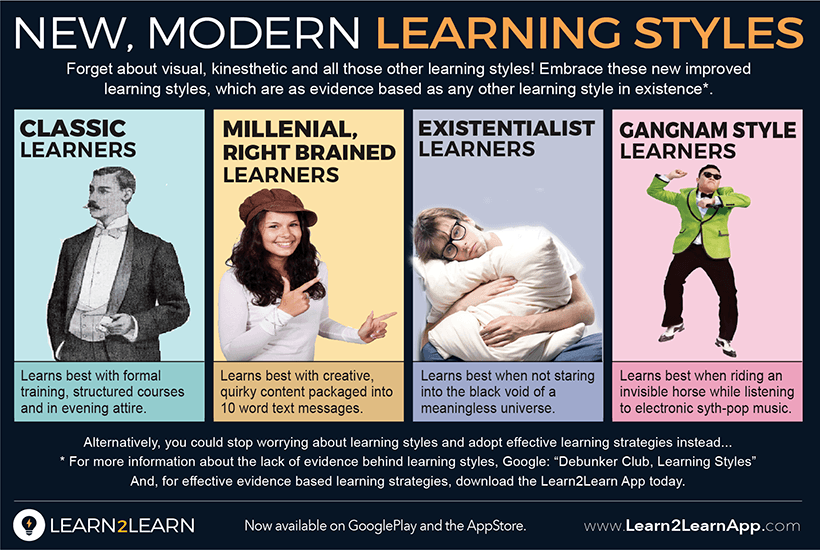
In the context of then many encephalon myths, popularizing evidence-based strategies such every bit spaced learning, retrieval practise, interleaving, and other counter-intuitive study techniques is a welcome addition to the conversation.
But information technology'southward only just the beginning of what'south required.
Adapting and thriving through this flow of accelerated change requires higher levels of learning agility.That means improved higher-club thinking, trouble-solving skills, and creativity, likewise every bit the ability to chop-chop larn and apply complex skills in varying situations.
Essentially, it means becoming a powerful agile learner, which y'all can preview in the image beneath.
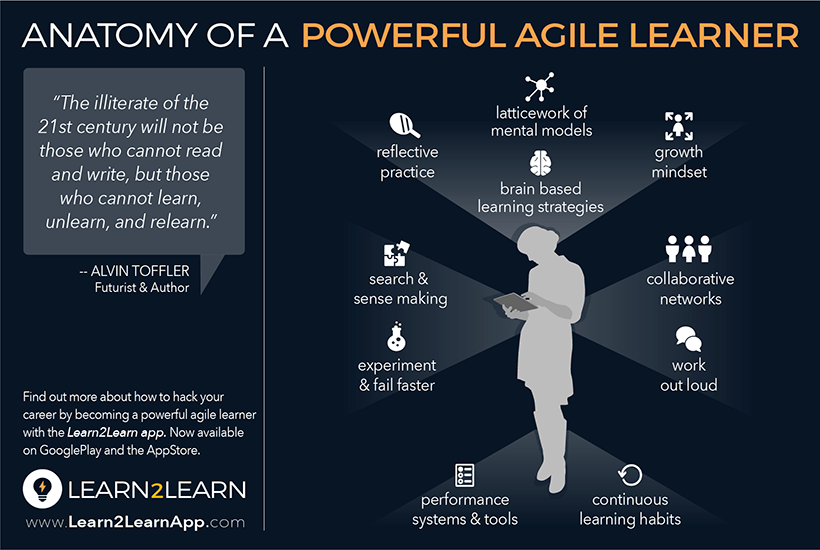
So, without farther delay, let's go beyond memory retention and explore9 meridian time to come-proofing techniques for learning agility.
ane. Develop Mindset
Perchance the least surprising strategy is to bring awareness to, and invest in, mindset. Stanford Academy Professor Carol Dweck has popularized the importance of a growth mindset which allows united states of america to comprehend challenges and constantly develop.
Other related and powerful attitudes include:
- Maintaining optimism through ambiguity.
Information technology involves holding the conventionalities that together we tin can find solutions out of the chaos. - Maintaining curiosity.
Information technology involves keeping a beginners mind that explores situations and problems without bias.
Mindsets tin can be complex beasts to shift. Bringing empathetic awareness to our internal vox is an excellent get-go but it will by and large crave cycles of effortful activeness and reflection to accomplish lasting modify.
Here's an example of how to develop 1 of these aspects, in the form of curiosity.
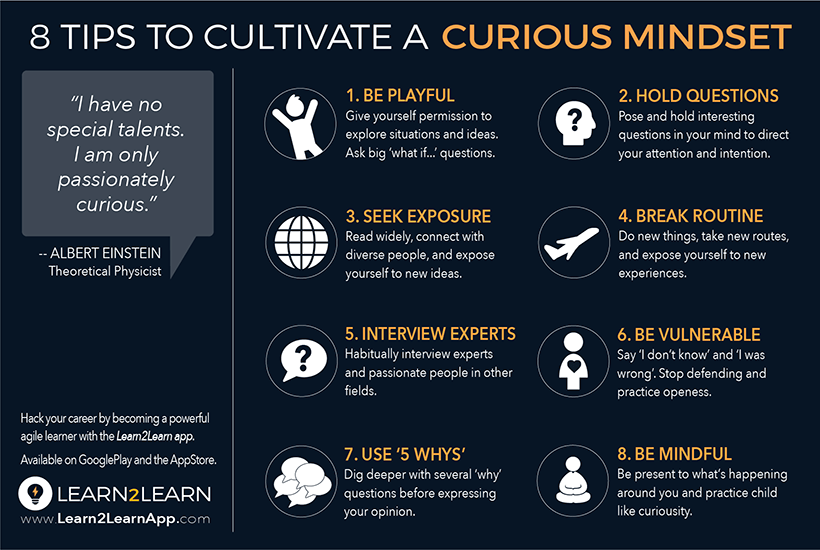
two. Acquire Less Information
We live in an era where a kid with a smartphone tin can out-fact a Mensa convention, and so why non comprehend opportunities to 'extend our brains' with technology? For instance, rather than memorizing directions, we only need to remember where we've left our telephone (i.e. our GPS) and this wonderful functioning tool will assistance u.s.a. attain our destination.
Other performance tools can be low-tech, similar the checklists championed by the surgeon and author Atul Gawande, or high-tech, such as searchable cognition bases, or chatbots. Either mode, they provide just-in-time back up, allowing us to achieve more while learning less, as captured in the post-obit cartoon.
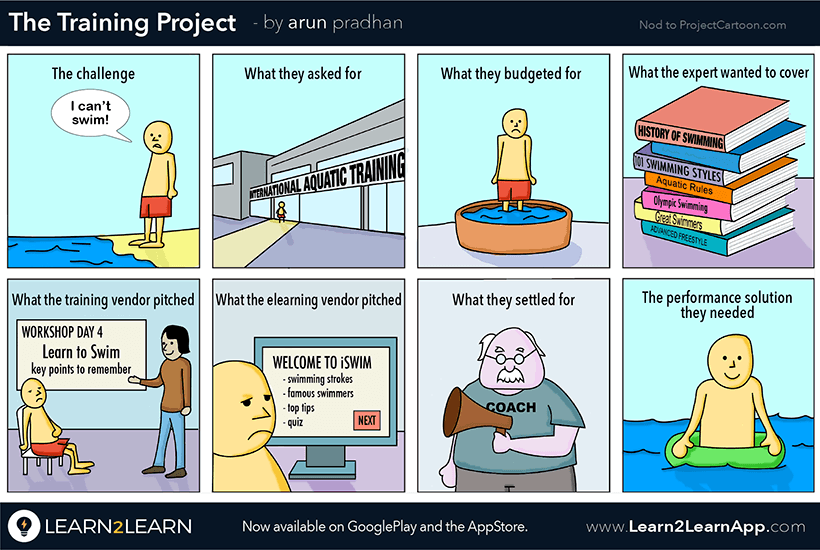
In today's abiding state of data overwhelm, embracing such techniques isn't only a matter of a convenience, it's a matter of necessity. By beingness strategic about what we commit to memory, and reducing cognitive load in the process, nosotros provide space for deeper thinking, which leads to the next indicate.
3. Learn More Mental Models
If we use those memory techniques I talked about earlier for anything, information technology should be for learning mental models.
Mental models are conceptual frameworks that help u.s. understand and act in the earth. From metaphors like 'desktops' on computers to frameworks like GROW in coaching, such models act every bit curt-cuts, allowing us to chop-chop understand and engage with the world.
Charles Munger, Warren Buffet's right-paw man, has literally made fortunes from taking the big ideas from a range of industries and incorporating them into his 'latticework of mental models'. Rather than having a unmarried cognitive tool to cope with challenges, striving for such diversity broadens out our cognitive toolkit and ability for divergent thinking.
Entrepreneur and investor, James Altucher, takes this farther with his concept of 'ideas sex'. His statement is: "Become expert at two or more areas, intersect them in a unique manner, and at present you are the best in the world at the intersection".
So, how do you lot pick up mental models?
At that place are many methods, including exposure to various experiences, ideas, industries, and people. Once you're engaged with learning a new concept, one of the near deceptively simple techniques you tin can use is the Feynman technique (and I adopt using it with my own addition of 'Myrtle', as described below):
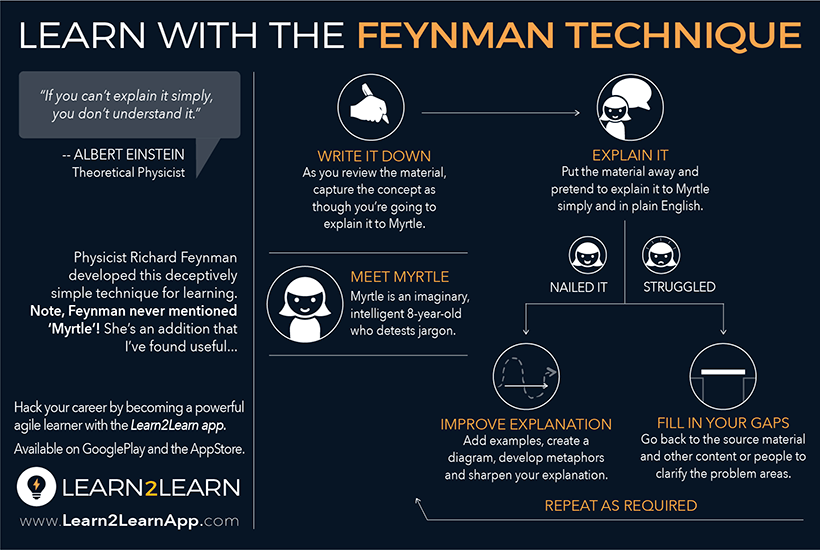
4. Be Witting Of The Unconscious
Tacit noesis refers to the understanding, beliefs, and lessons nosotros've absorbed, primarily through experience, that cannot easily be put into words. In his acknowledged book Blink, Malcolm Gladwell described benefits of deep tacit knowledge, citing examples of fine art experts who can 'sense' fake artwork. The negative side of this was explored past Daniel Kahneman in Thinking Fast and Slow, where he unpacked the nature and mechanics of unconscious bias.
This is a circuitous topic, only the main takeaways are to be aware of our biases and know when to adopt 'wearisome thinking' to take a more considered view. Information technology's walking the tight-rope of using tacit cognition in areas where we take experience and expertise while being aware that such shortcuts are inherently prone to bias.
5. Learn To Unlearn
Speaking of biases, one of the big ones is 'confirmation bias' or the tendency to detect and interpret information that reinforces our current beliefs.
The Kodak story is a archetype example of a business which couldn't unlearn in the face of disruption. You're probably aware of other examples of individuals living in deprival nearly their changing reality until it was too late for them to arrange.
Letting go of deeply held mental models is one of the almost challenging aspects of learning agility. There are a number of techniques that can support effective unlearning, some of which are captured in the post-obit infographic.
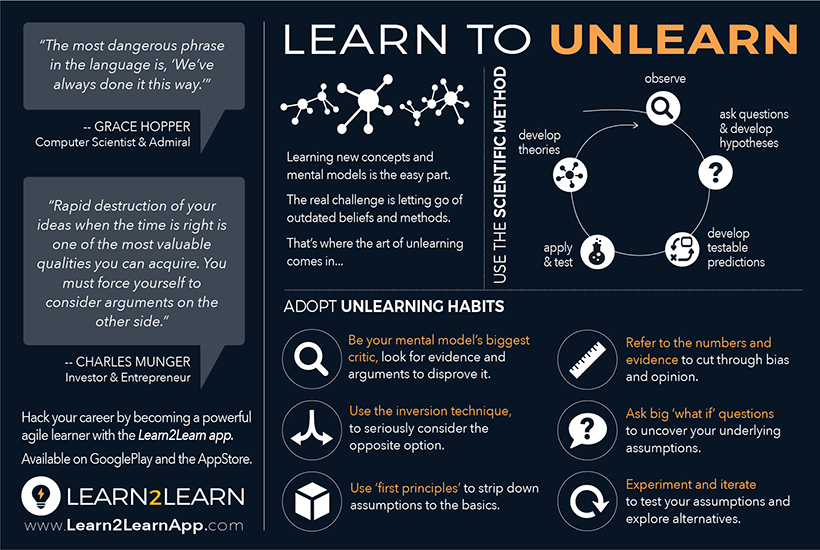
six. Targetted Practise
In Outliers, another acknowledged book by Malcolm Gladwell, he popularized the idea that it takes at least x,000 hours to get an expert. Since then, Anders K Ericsson, the researcher behind this claim, has published Summit, his own compelling book, to stress that developing mastery is less about time and more about deliberate do.
In contrast to mindless repetition, deliberate exercise includes seeking adept feedback to identify and practice our weak spots in relation to our goals.
vii. Work Out Loud
Just as performance tools 'extend' our brain, developing an all-encompassing collaborative network extends and develops our capability. In our new and increasingly complex earth, 'know who' and the power to depict on various networks for support, is a game changer.
At that place are a number of aspects to this, from working effectively in a team, fostering a community of exercise, and engaging with broad networks. One approach that assists with all of these groups is 'working out loud'. This technique championed past the likes of John Stepper involves sharing our work in progress, actively contributing to others, and developing meaningful collaborative relationships as a result.
8. Stretch And Neglect Fast
Working with ambiguity requires cycles of exploration, testing, and learning. This includes apace prototyping ideas to quickly examination assumptions and empathize our audience, state of affairs and/or challenge. A key aspect of such experimentation is understanding that failure is part of the journey as we stretch beyond our comfort zone to accelerate our learning and affect.
This is a huge topic which I'll explore in a hereafter commodity. It'south been greatly informed past the work of people like Amy Edmondson and the investigation around psychological safety as a key cistron to back up a civilization of learning and high performance.
A meaning part of this is to finish the 'blame game' and provide a context where failure is identified and talked about without shame.
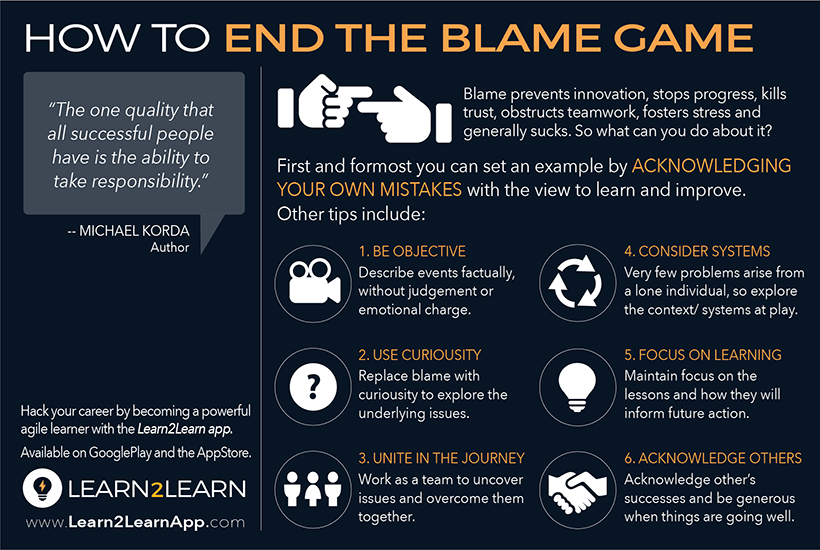
9. Embed Reflective Habits
In The Power of Habit, Charles Duhigg outlined 3 elements of addiction formation every bit a cue, routine, and reward. Leveraging such behavioural loops are crucial to embed change because nosotros know that motivation more often than not doesn't last.
Stanford University's B.J. Fogg developed this into his argument for 'tiny habits' which consist of daily, low attempt actions tied to cues such equally having a shower or buying a coffee. Choosing cues to prompt brusk reflective moments volition provide the fourth dimension and space for united states to ameliorate acquire from failure, shift mindset, and abstruse experiences to develop and combine mental models.
Other ways to meliorate reflection are explored in the following image.
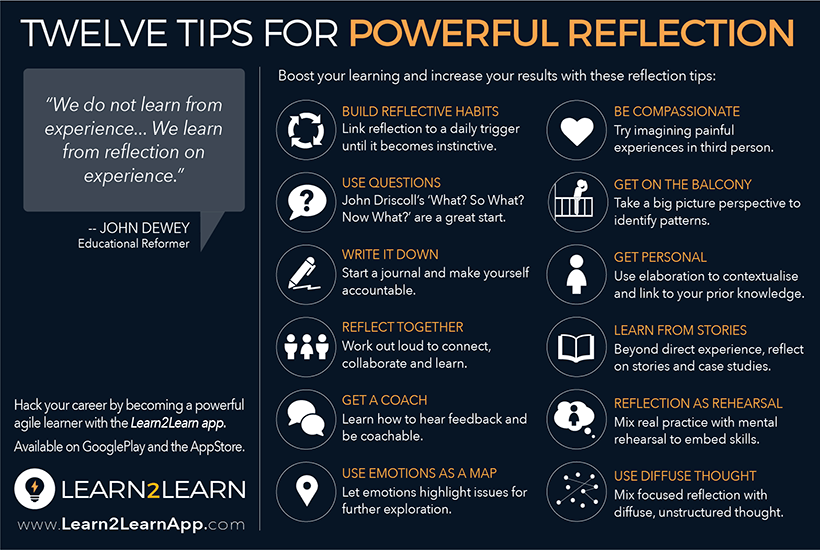
Terminal Words
These nine strategies correspond a quick preview of the 18 topics explored in myrecently launched Learn2Learn app. It's likely that you're already employing many of them and no incertitude there's plenty of room for improvement in others.
My parting advice is to be empathetic with yourself every bit you go on to develop and make sure yous don't go information technology alone. Forming groups, leveraging mentors or coaches, and just working out loud will all help to keep you on track and stay sane.
In our rapidly changing world you won't know where this will have you only, by embracing these strategies, you lot're more likely to enjoy the ride.
----
All images in this article are from theLearn2Learn app, which is now available on GooglePlay and the AppStore.
Here are some of the reviews so far:
"In my view, anyone involved in improving performance and exploiting opportunities for learning in their organization should download this app."
- Charles Jennings, Co-Founder of the 70:20:10 Constitute.
"Learn2Learn is an app, a guide, a reference and a personal action program for exploring and expanding your cerebral abilities."
- Connie Malamed, eLearning Jitney, Consultant & Author.
"Information technology's been groovy to add this as a development tool for my ain learning since rapid personal development goes with the territory at a identify like Shopify."
- Katrina Moss, Learning Acceleration Atomic number 82 at Shopify.
"This app will fuel your learning on an ongoing basis, regardless of your domain. Go this app, employ information technology, stretch yourself and see yourself grow."
- Michelle Ockers, Modern Workplace Learning Practitioner & Strategist.
An enterprise web app version of Learn2Learn for organizations, including a Learning Agility in Teams guide, will be available in April 2018. Please connect with and contact Arun Pradhan for business inquiries.
Source: https://elearningindustry.com/achieve-learning-agility-future-proof-age-disruption-9-techniques
Posted by: whitesideitere1944.blogspot.com


0 Response to "How To Increase Learning Agility"
Post a Comment